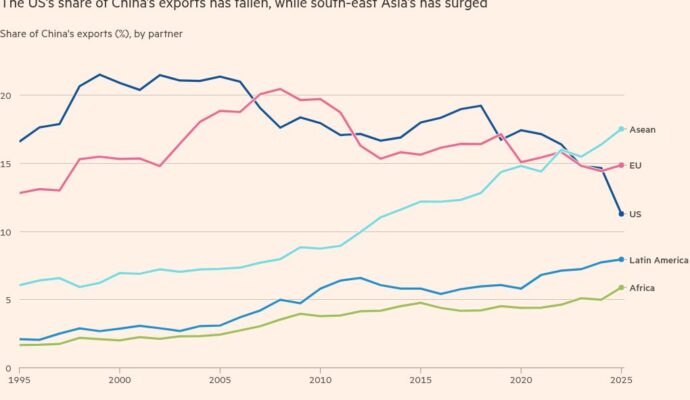Stay informed with free updates
Simply sign up to the Chinese business & finance myFT Digest — delivered directly to your inbox.
Chinese fast-fashion retailer Urban Revivo has stepped up ambitious plans to challenge the likes of Zara and H&M by expanding in London in a revived push into international markets.
The retailer is part of a wave of Chinese companies — from Labubu-maker Pop Mart to EV giant BYD — pushing to “chuhai” or “go overseas” as China’s hyper-competitive markets mature and its economic growth slows.
“Our strategy is to use London and New York as the fulcrum of our globalisation to tap into overseas markets,” said Li Guangming, the company’s founder and chair of its parent company Fashion Momentum Group.
“When we started in China, we had no brand recognition. In London and New York, we have zero visibility; we’re starting from scratch.”
Urban Revivo has opened a 30,000 sq ft store in the city’s Westfield mall, and also has new locations in Covent Garden and New York’s Soho district. It previously had an outlet in London in 2018 but it shut soon after as a result of the pandemic.
Li said the company’s strategy was similar to when it opened its Shanghai store in 2008. “If we could develop in Shanghai, we felt expanding into other Chinese markets outside of Shanghai would be much easier,” he said.
Li founded Urban Revivo’s parent company in 2006 because he “liked clothes and wanted to start a clothing brand”. The retailer has expanded across the mainland where it now has about 400 stores. It has opened 23 stores overseas, with the first opening in Singapore in 2016.
In a two-storey store just off Shanghai’s Nanjing Road, one of China’s most famous shopping destinations, Urban Revivo’s racks of clothing, bags and hats evoke the layout and ambience of its larger western competitors.
“We did learn from Zara’s business model,” said Li, in response to a question about comparisons with the Inditex-owned brand, “just like JD.com in China learned from Amazon’s business model, Nio and Li Auto learned from Tesla, and Huawei and Xiaomi learned from Apple.”
But he said Urban Revivo’s products were more “localised” than those made by some foreign rivals, referring to items tailored to particular styles and fits in a given city or region, and added that China’s demanding consumer environment forced the company to adapt.
“In the past the term ‘fast fashion’ was synonymous with poor quality in China,” he said. “So we prioritised quality.”
23
The number of Urban Revivo’s international stores
Urban Revivo, which is privately held, operates on a much smaller scale than major international rivals. The company confirmed it had revenues of Rmb6bn ($840mn) in 2022 but would not disclose more recent figures. It declined to comment on the prospects of a rumoured IPO.
“We had some pressure last year but things have rebounded this year,” said Li.
Urban Revivo has a target of generating Rmb5bn in revenues outside of China by 2030. That would still be a fraction of the €28bn of global sales last year for Zara, which in 2023 expanded its own presence in Westfield Centre to 57,000 sq ft.
Although the company cites its “fair prices” as an advantage, the clothes are more expensive than some online options in China. Plain white T-shirts in the Shanghai store cost Rmb99, while trousers retail at Rmb199.
One shopper visiting from the central city of Zhengzhou said she preferred the clothes to those with a “Taobao feeling”, a reference to the inexpensive clothing options available on the country’s biggest ecommerce platform owned by tech group Alibaba.
Urban Revivo has also increased its mainland presence, with prominent stores in Nanjing in 2023 and Beijing this year.
“Clearly they are reinforcing their presence in the key commercial areas in China, that’s very public for everyone to see,” said one industry veteran on the mainland, who spoke on condition of anonymity.
While its suppliers are all within China, Li said the company could start manufacturing in Turkey, Morocco and Vietnam.
Li acknowledged the “juan”, or excessive competitiveness, of the mainland market, but said its overseas plans were ultimately driven by long-term factors.
“We must expand internationally as soon as possible,” he said. “Opening stores in Europe will force us to internationalise our products . . . that way we can better prepare for consumer changes in 20 or 30 years.”
“I personally don’t think we are going overseas based on short-term economic or social changes in a country,” said Li. “We’re expanding based on a 30- to 50-year trajectory.”
Additional reporting by Wang Xueqiao in Shanghai


